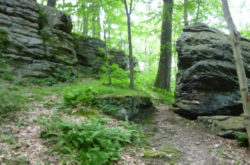Jumonville Glen lies along Che stnut Ridge, southeast of Uniontown, not far from the Summit Inn on Route 40 or from Camp Jumonville. It is administered and maintained by the National Park Service as part of the Fort Necessity National Battlefield. The glen lies quietly in a densely wooded area, defined by its large rock outcrops that are essential in understanding the history of the site.
stnut Ridge, southeast of Uniontown, not far from the Summit Inn on Route 40 or from Camp Jumonville. It is administered and maintained by the National Park Service as part of the Fort Necessity National Battlefield. The glen lies quietly in a densely wooded area, defined by its large rock outcrops that are essential in understanding the history of the site.
While the area is popular for its natural beauty and numerous hiking trails, what is remarkable about Jumonville Glen is how unchanged it is since the event took place in 1754 that made it famous. It is a “sleeper” historical site in that it is not widely known or visited like other major historical attractions. However, the events that took place here helped to shape the dynamics of colonialism of the day and impacted the birth of the United States as we know it today.
In 1754, a small contingency of troops, led by young George Washington, was sent by British command in Virginia to help construct a fort at the “forks of the Ohio” in present-day Pittsburgh. Upon learning that the French had already claimed the spot with the construction of Fort Duquesne, they turned back toward Virginia. A smaller group, led by Washington, broke off to determine the extent of French influence in the area. While camped at Great Meadows (present day Fort Necessity), Washington was notified of the presence of French troops encamped just a few miles away at what would become known as Jumonville Glen. This notification came from a Native American leader named Tanacharison, also known in a somewhat derogatory fashion as “Half-King” since his authority was limited and granted by the authority of the Seneca tribe in the eastern Great Lakes region. Tanacharison, like most Native American leaders, was politically astute and keenly aware of European influence, and made chess moves to the benefit of the Native American interests.
The French contingent was under the command of Ensign Joseph Coulon de Villers, Sieur de Jumonville. The troops were having breakfast in the glen on the morning of May 27, 1754 at the time of Washington’s reconnaissance. It is unclear what triggered the first shot that morning, or by which side, but a 15-minute battle ensued, leaving 10 French dead and 21 captured. Jumonville himself was one of the dead. The prisoners were sent to Williamsburg, VA, while Washington stayed behind to construct a “fort of necessity” at Great Meadows. He realized that the French would strike back and strike back hard for such aggression. In short, this was a blunder that sparked the French and Indian War, also known as the Seven Years war between England and France – both in North America and Europe. Native Americans were also caught up in the war as they attempted to protect their interests.
Today, Jumonville Glen is clearly signed from Jumonville Road and is accessed by a small gravel road to a parking area. From here, steps are provided to access the encampment area below Washington Rocks. Several marked hiking trails proceed from this area. One trail heading to the N-NE will arrive at Green Cathedral, maintained by the neighboring Jumonville Camp & Conference Center. Green Cathedral is picturesque clearing in the woods, with several man-made ponds, lawn areas and features, including a small amphitheater. For history buffs and nature lovers alike, Jumonville Glen is a must-see!
References:
Jumonville Glen – National Park Service
Jumonville Glen Trail – Live & Let Hike
Further Reading:
French & Indian War: A History From Beginning to End (Native American History Book 4)
